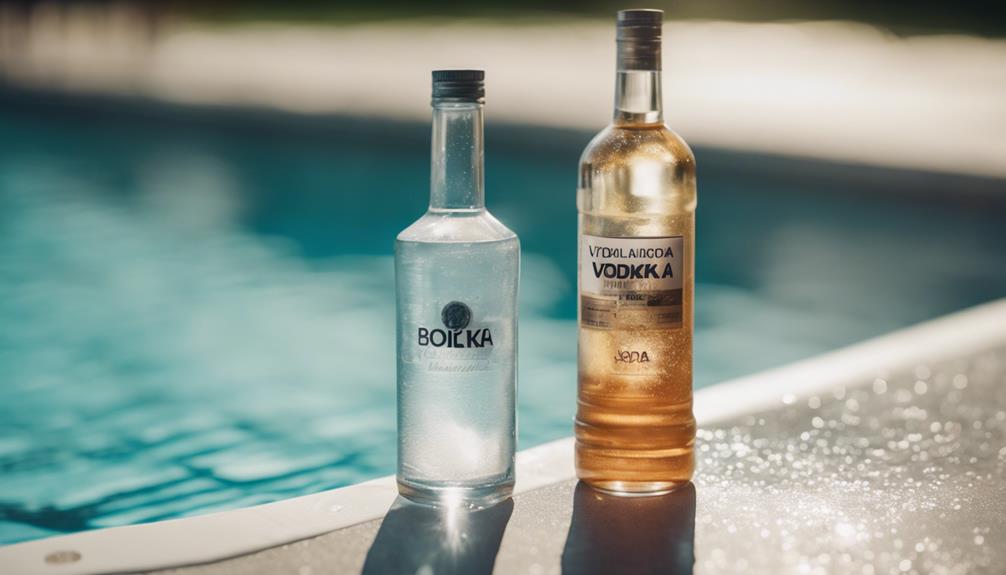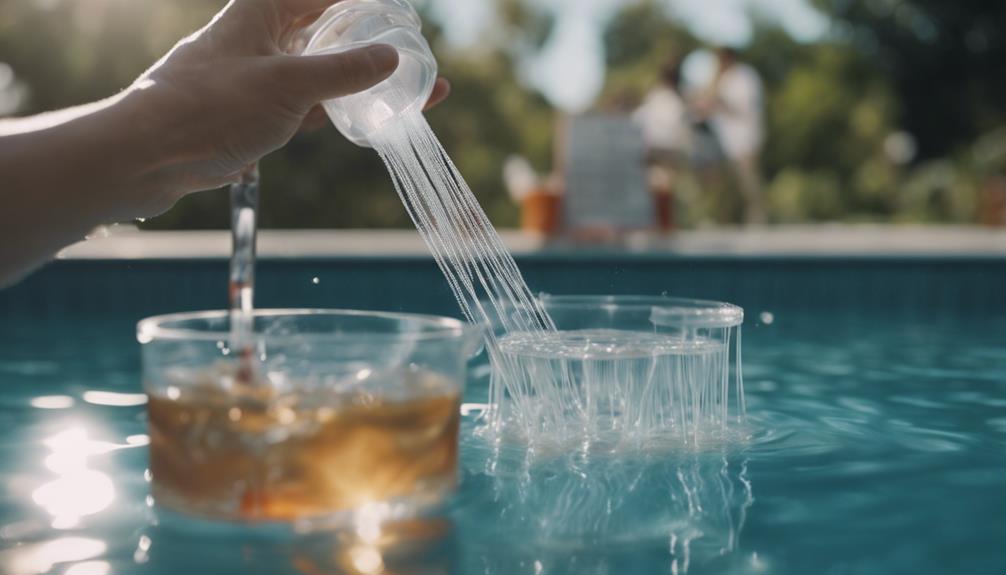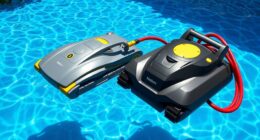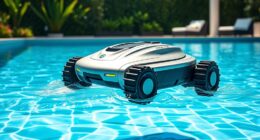Using vodka to maintain your pool is not recommended. Vodka does not have the necessary sanitizing properties for pool maintenance, which can disrupt the water’s chemical balance and increase the risk of algae growth. Despite some claims, vodka cannot effectively fight bacteria or maintain water quality like chlorine can. Its low pH level may create unsuitable water conditions for swimming. To ensure a clean and safe swimming environment, it is best to use recommended pool cleaning products and techniques. For more information on how to preserve your pool’s cleanliness and safety standards, you can refer to the researched information provided.
Key Takeaways
- Vodka is not suitable for pool cleaning due to pH imbalance and lack of sanitizing properties.
- Chlorine, not vodka, is essential for maintaining proper water balance and sanitizing pools.
- Vodka can lead to algae growth and cloudy water, disrupting the pool's chemical balance.
- Vodka's alcohol content causes unpleasant odors and is not an effective cleaning agent.
- Proper pool maintenance involves using chlorine and regular testing for safe water quality.
The Viral Vodka Pool Cleaning Trend
The viral trend of cleaning pools with vodka has sparked debate among pool owners and experts. While a video circulating on social media suggests pouring vodka into your pool for four days can enhance cleanliness, pool maintenance professionals don't support this method.
The claims made in the video about vodka being a viable pool cleaning agent aren't backed by experts in the field. In reality, using vodka to clean your pool isn't an effective or recommended practice. Pool cleaning requires the use of specific chemicals, such as chlorine, to maintain proper sanitation levels and prevent the growth of harmful bacteria.
Contrary to the suggestions in the viral video, adding vodka to your pool may not only be ineffective but also potentially harmful to the pool's chemical balance. It's essential to adhere to industry-recommended guidelines for pool maintenance to guarantee a safe and hygienic swimming environment for you and your family.
Properties of Vodka Vs. Chlorine

Vodka and chlorine differ significantly in their properties when it comes to pool cleaning.
While vodka's pH of 4 can disrupt water balance, chlorine is essential for maintaining proper pH levels in pools.
Additionally, chlorine's sanitizing properties are vital for killing bacteria, a feature lacking in vodka.
Vodka's Cleaning Effectiveness
When comparing cleaning effectiveness, chlorine outperforms vodka due to its superior sanitizing properties and ability to maintain proper chemical levels in pools. Chlorine is a trusted pool cleaner because of its efficiency in sanitizing water effectively and ensuring the right chemical balance.
In contrast, vodka lacks the necessary sanitizing properties to kill bacteria effectively in pools. Additionally, the pH balance of vodka, around 4, can disrupt pool water chemistry, potentially leading to imbalances and unpleasant odors. Vodka may not provide thorough cleaning for pools, especially when compared to dedicated pool cleaning agents.
Using vodka for pool cleaning could result in issues such as algae growth and cloudy water due to its limitations in maintaining pool hygiene. For the best pool cleanliness and safety, it's recommended to rely on chlorine or other suitable pool cleaning products that are specifically designed to address the cleaning needs of pools.
Safety Considerations for Vodka
Comparatively, chlorine's pH level helps maintain the appropriate chemical balance in pools for safe swimming, unlike vodka's pH of 4. Chlorine plays an essential role in sanitizing pools by effectively killing bacteria, ensuring a hygienic environment for swimmers.
In contrast, vodka lacks the sanitizing properties necessary to keep pool water clean and safe. Prolonged use of vodka can lead to algae growth and murky water due to its ineffectiveness in combating contaminants. Additionally, vodka can introduce unpleasant odors into the pool, compromising the overall swimming experience.
It is vital to understand the differences in properties between vodka and chlorine to make informed decisions regarding pool maintenance and safety. While chlorine helps regulate chlorine levels and maintain water quality, vodka falls short in effectively cleaning and sanitizing pool water.
Therefore, relying on vodka as a pool cleaning agent can pose risks to the health and well-being of swimmers. Prioritizing the use of chlorine over vodka is key to ensuring a safe and enjoyable swimming environment for all.
Impact on Pool Water Quality

Using vodka to clean your pool can greatly degrade the quality of the water, posing potential risks to swimmers. The impact on pool water quality is significant, leading to various issues that compromise the safety and enjoyment of your swimming experience.
Here are some key points to take into account:
- Vodka can disrupt the chemical balance of pool water, making it unsuitable for swimming.
- Chemical imbalances caused by vodka may render the water unsafe due to inadequate sanitization.
- Vodka lacks the necessary properties to effectively clean and maintain pool water.
- Prolonged use of vodka in pool cleaning can result in the growth of algae and cloudy water.
- The pH imbalance caused by vodka can lead to unpleasant odors in the pool water.
Considering these factors, it's essential to prioritize the use of proper pool cleaning products to guarantee a safe and enjoyable swimming environment for you and your guests.
Effectiveness Against Bacteria

Using vodka to clean your pool may not effectively combat bacteria due to its lack of sanitizing properties. Chlorine remains the superior choice for eliminating harmful bacteria and maintaining proper pool sanitation.
Relying solely on vodka as a pool cleaner could lead to bacterial growth and potential health risks, emphasizing the necessity of a chlorine-based approach for ensuring a safe swimming environment.
Bacteria and Vodka
While vodka may seem like a unique approach to cleaning your pool, its effectiveness against bacteria is limited. When it comes to combating bacteria in pools, using vodka may not provide the necessary sanitization properties to guarantee a bacteria-free environment.
Here are some key points to keep in mind:
- Vodka lacks the sanitization properties needed to effectively kill all bacteria in a pool.
- Bacteria in pools may not be completely eliminated by using vodka as a cleaning agent.
- Proper sanitization with chlorine or other suitable chemicals is vital for combating bacteria in pools.
- Long-term use of vodka for pool cleaning may not address bacterial growth adequately.
- Vodka's alcohol content may not be sufficient to maintain a bacteria-free pool environment.
For a truly clean and safe pool environment, it's essential to utilize appropriate sanitization methods recommended for pools to effectively tackle bacterial growth and maintain water quality.
Vodka as Sanitizer
When considering vodka as a sanitizer for your pool, it's important to understand its limitations in effectively combating bacteria due to its lack of sanitization properties compared to chlorine. Vodka, with its lower alcohol content, may not be as effective in killing harmful bacteria present in pool water.
Unlike chlorine, which is a preferred sanitizer for pools due to its proven ability to eradicate bacteria, vodka's alcohol levels may not provide adequate sanitization. Proper pool maintenance, including regular chlorination, plays an essential role in ensuring bacteria-free pool water.
While vodka may have certain cleaning properties, it isn't a reliable substitute for chlorine when it comes to maintaining a safe and bacteria-free swimming environment. Therefore, relying solely on vodka as a sanitizer for your pool may not be sufficient in ensuring the health and safety of swimmers.
It's advisable to follow recommended pool maintenance practices, including the use of appropriate sanitizers like chlorine, to effectively combat bacteria and maintain a hygienic swimming environment.
Ph Balance Disruption

Disrupting the pH balance of your pool, vodka with its pH of 4 can create unsafe swimming conditions and unpleasant odors in the water. When vodka is introduced into a swimming pool, it can lead to detrimental effects on the water quality due to its acidic nature.
Here are some key points to take into account regarding pH balance disruption caused by vodka:
- Vodka's pH of 4 can notably alter the pool water's pH levels.
- The chemical imbalances triggered by vodka can render the water unsuitable for swimming.
- Unsafe pH levels resulting from vodka can pose health risks to swimmers.
- Vodka-induced pH disruptions may lead to the development of foul odors in the pool.
- Proper maintenance of pH levels is essential for ensuring water safety and clarity in your pool.
Maintaining the correct pH balance in your pool is vital to provide a safe and enjoyable swimming experience for you and your guests.
Algae Growth Concerns

Using vodka in pools can lead to algae growth concerns due to its lack of sanitization properties. Algae growth in pools can be a result of vodka's insufficient bacteria-killing abilities, creating conditions conducive to algae development. The pH imbalance caused by vodka in swimming pool water further exacerbates the problem by providing a favorable environment for algae to thrive.
The disruption of the pool's chemical balance by vodka can lead to cloudiness and promote algae growth, posing challenges for pool maintenance. It is essential to understand that vodka's inability to prevent algae growth makes it an ineffective and potentially problematic pool cleaning solution. Without proper sanitization properties, vodka fails to address the root causes of algae growth concerns in swimming pools.
To maintain a clean and algae-free pool, it's advisable to use appropriate pool cleaning products and methods that effectively combat algae growth and ensure a healthy swimming environment.
Vodka's Odor Issues

Vodka's alcohol content can lead to unpleasant odors in your pool. When using vodka for cleaning, the smell of vodka can become a noticeable issue that affects the overall pool experience.
Here are some key points to take into account regarding vodka's odor issues:
- The smell of vodka in pool water can be off-putting to swimmers.
- Vodka's strong odor may linger in the pool area after cleaning.
- The fragrance of vodka can be overwhelming in enclosed pool spaces.
- Pool users may find the smell of vodka in the water undesirable.
- Proper ventilation and additional water treatments may be necessary to mitigate the persistent smell of vodka in the pool.
Taking these factors into consideration is vital when deciding to use vodka for pool maintenance, as the odor issues associated with vodka can impact the enjoyment of your swimming environment.
Proper Pool Maintenance Techniques

Proper maintenance techniques for your pool are essential to guarantee a clean and safe swimming environment. Regularly skimming debris from the water's surface and brushing or vacuuming the pool walls and floor help prevent the buildup of dirt and algae.
Additionally, cleaning the pool filter on a routine basis is important for maintaining ideal water circulation and filtration. Testing the water regularly to make sure the chemical balance is safe is also essential for creating a healthy swimming environment.
If you notice algae growth or the water becoming dirty, shocking the pool with chlorine can help address these issues effectively. By following these cleaning and maintenance practices consistently, you can ensure that your swimming pool remains clean, safe, and enjoyable for everyone to use.
Expert Recommendations on Pool Cleaning

For ideal pool cleanliness and maintenance, adhere to expert recommendations on effective cleaning techniques.
- Skim and Remove Debris: Regularly skim leaves, insects, and other debris from the pool surface to prevent buildup and contamination.
- Brush or Vacuum Pool Walls: Brush or vacuum the pool walls and floor to remove sediment and prevent algae growth in hard-to-reach areas.
- Clean the Pool Filter: Regularly check and clean the pool filter to guarantee proper filtration and water circulation, maintaining water clarity.
- Test Water Chemical Balance: Test the water regularly for safe chemical balance, especially chlorine levels, to prevent algae growth and maintain water quality.
- Shock with Chlorine When Needed: Shock the pool with chlorine when facing algae or significant dirt buildup to sanitize the water and restore chemical balance for a clean swimming experience.
Following these expert recommendations will help you quarantine pool clean and secure a safe, enjoyable swimming environment for you and your guests.
Frequently Asked Questions
What Is the Ratio of Vodka to Water for Cleaning?
For effective pool cleaning, the recommended ratio of vodka to water is typically 1 part vodka to 2 parts water. This diluted mixture helps maintain the pool's chemical balance and prevents disruptions to pH levels.
Using too much vodka can lead to potential issues, so it's essential to follow the proper dilution ratio. Ensuring the correct balance of vodka and water is vital for safe and efficient pool maintenance.
Can I Use Vodka to Clean a Toilet?
Can you use vodka to clean a toilet effectively?
While vodka can disinfect and remove stains in toilets due to its alcohol content, it may not be the most cost-effective option compared to traditional cleaners.
Mixing vodka with water or vinegar can enhance its cleaning power, but consider the price before using it as your primary toilet cleaner.
It's essential to evaluate both effectiveness and cost when deciding on cleaning products.
How Do You Disinfect With Vodka?
Disinfecting with vodka isn't effective for pools due to its inability to kill harmful bacteria and its potential to disrupt the pool's pH balance, leading to issues like algae growth and cloudy water.
Professional pool disinfectants like chlorine are recommended for efficient pool cleaning. It's essential to use products specifically designed for pool maintenance to guarantee a safe and clean swimming environment for you and your loved ones.
How Do You Clean Floors With Vodka?
When cleaning floors with vodka, it's important to factor in the potential risks and inefficiencies involved.
Vodka isn't a recommended method due to its inability to thoroughly clean pool surfaces, leading to unsafe swimming conditions. The chemical imbalance caused by vodka can disrupt water balance and create safety concerns.
Opting for more suitable cleaning approaches beyond surface cleaning is essential to maintain a safe and properly sanitized pool environment.
Is Using Vodka as a Pool Cleaner Safe and Effective Compared to Chlorine Alternatives?
When considering alternative pool water cleaning methods, using vodka as a pool cleaner may seem like an unconventional idea. However, vodka contains alcohol, which can help kill bacteria and algae in the pool water. While it may be effective to some extent, it is not as safe and reliable as traditional chlorine alternatives.
Conclusion
To sum up, using vodka to clean your pool isn't a recommended practice. While it may seem like a trendy alternative to traditional chlorine, vodka lacks the necessary properties to effectively sanitize pool water and combat bacteria.
In fact, according to experts, using vodka can actually disrupt the pH balance of your pool, leading to potential algae growth issues.
Stick to proven pool cleaning methods to guarantee the safety and cleanliness of your pool.










